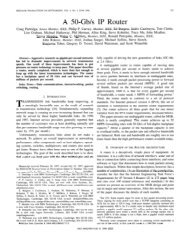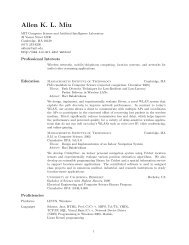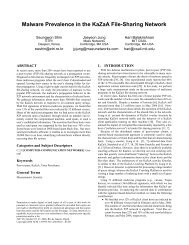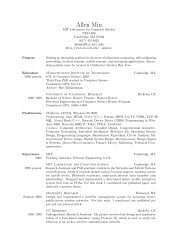Chord - Networks and Mobile Systems - MIT
Chord - Networks and Mobile Systems - MIT
Chord - Networks and Mobile Systems - MIT
Create successful ePaper yourself
Turn your PDF publications into a flip-book with our unique Google optimized e-Paper software.
Path length<br />
12<br />
10<br />
8<br />
6<br />
4<br />
2<br />
1st <strong>and</strong> 99th percentiles<br />
0<br />
1 10 100 1000<br />
Number of nodes<br />
10000 100000<br />
(a)<br />
PDF<br />
<br />
0.25<br />
0.2<br />
0.15<br />
0.1<br />
0.05<br />
0<br />
0 2 4 6<br />
Path length<br />
(b)<br />
8 10 12<br />
Figure 10: (a) The path length as a function of network size. (b) The PDF of the path length in the case <br />
<br />
of a node network.<br />
Failed Lookups (Fraction of Total)<br />
<br />
0.08<br />
0.07<br />
0.06<br />
0.05<br />
0.04<br />
0.03<br />
0.02<br />
0.01<br />
95% confidence interval<br />
0<br />
0 0.02 0.04 0.06 0.08 0.1<br />
Node Fail/Join Rate (Per Second)<br />
Figure 12: The fraction of lookups that fail as a function of<br />
the rate (over time) at which nodes fail <strong>and</strong> join. Only failures<br />
caused by <strong>Chord</strong> state inconsistency are included, not failures<br />
due to lost keys.<br />
the key may have failed. Second, some nodes’ finger tables <strong>and</strong><br />
predecessor pointers may be inconsistent due to concurrent joins<br />
<strong>and</strong> node failures. This section evaluates the impact of continuous<br />
joins <strong>and</strong> failures on lookups.<br />
In this experiment, a lookup is considered to have succeeded if<br />
it reaches the current successor of the desired key. This is slightly<br />
optimistic: in a real system, there might be periods of time in which<br />
the real successor of a key has not yet acquired the data associated<br />
with the key from the previous successor. However, this method allows<br />
us to focus on <strong>Chord</strong>’s ability to perform lookups, rather than<br />
on the higher-layer software’s ability to maintain consistency of its<br />
own data. Any query failure will be the result of inconsistencies in<br />
<strong>Chord</strong>. In addition, the simulator does not retry queries: if a query<br />
is forwarded to a node that is down, the query simply fails. Thus,<br />
the results given in this section can be viewed as the worst-case<br />
scenario for the query failures induced by state inconsistency.<br />
Because the primary source of inconsistencies is nodes joining<br />
<strong>and</strong> leaving, <strong>and</strong> because the main mechanism to resolve these inconsistencies<br />
is the stabilize protocol, <strong>Chord</strong>’s performance will be<br />
sensitive to the frequency of node joins <strong>and</strong> leaves versus the frequency<br />
at which the stabilization protocol is invoked.<br />
In this experiment, key lookups are generated according to a<br />
Poisson process at a rate of one per second. Joins <strong>and</strong> failures<br />
are modeled by a Poisson process with the mean arrival rate of .<br />
Each node runs the stabilization routines at r<strong>and</strong>omized intervals<br />
averaging 30 seconds; unlike the routines in Figure 7, the simulator<br />
updates all finger table entries on every invocation. The network<br />
starts with 500 nodes.<br />
Figure 12 plots the average failure rates <strong>and</strong> confidence intervals.<br />
A node <br />
failure rate of corresponds to one node joining <strong>and</strong><br />
leaving every 100 seconds on average. For comparison, recall that<br />
each node invokes the stabilize protocol once every 30 seconds.<br />
In other words, the graph axis ranges from a rate of 1 failure<br />
per 3 stabilization steps to a rate of 3 failures per one stabilization<br />
step. The results presented in Figure 12 are averaged over approximately<br />
two hours of simulated time. The confidence intervals are<br />
computed over 10 independent runs.<br />
The results of figure 12 can be explained roughly as follows. The<br />
simulation has 500 nodes, meaning lookup path lengths average<br />
around . A lookup fails if its finger path encounters a failed node.<br />
If nodes fail, the probability that one of them is on the finger <br />
path<br />
is roughly , or . This would suggest a failure rate of<br />
<br />
about % if we have 3 failures between stabilizations. The graph<br />
shows results in this ball-park, but slightly worse since it might take<br />
more than one stabilization to completely clear out a failed node.<br />
6.6 Experimental Results<br />
This section presents latency measurements obtained from a prototype<br />
implementation of <strong>Chord</strong> deployed on the Internet. The<br />
<strong>Chord</strong> nodes are at ten sites on a subset of the RON test-bed<br />
in the United States [1], in California, Colorado, Massachusetts,<br />
New York, North Carolina, <strong>and</strong> Pennsylvania. The <strong>Chord</strong> software<br />
runs on UNIX, uses 160-bit keys obtained from the SHA-1 cryptographic<br />
hash function, <strong>and</strong> uses TCP to communicate between<br />
nodes. <strong>Chord</strong> runs in the iterative style. These <strong>Chord</strong> nodes are<br />
part of an experimental distributed file system [7], though this section<br />
considers only the <strong>Chord</strong> component of the system.<br />
Figure 13 shows the measured latency of <strong>Chord</strong> lookups over a<br />
range of numbers of nodes. Experiments with a number of nodes<br />
larger than ten are conducted by running multiple independent<br />
copies of the <strong>Chord</strong> software at each site. This is different from<br />
running £¥¤§¦©¨<br />
balance; rather, the intention is to measure how well our implementation<br />
scales even though we do not have more than a small number<br />
of deployed nodes.<br />
For each number of nodes shown in Figure 13, each physical<br />
site issues 16 <strong>Chord</strong> lookups for r<strong>and</strong>omly chosen keys one-byone.<br />
The graph plots the median, the 5th, <strong>and</strong> the 95th percentile<br />
¢ virtual nodes at each site to provide good load











